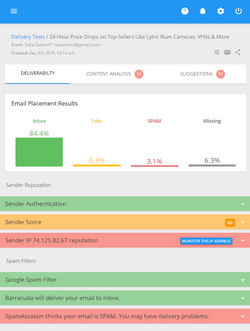How to Deliver Emails to Hotmail: Read These 6 Tips
When it comes to email delivery, one of the serious challenges email marketers have to deal with is delivering emails to AOL users. Email messages and the whole sending process must be optimized and tailored to meet specific AOL features and requirements.
Similarly to AOL, Hotmail also uses several criteria to decide whether to deliver an email or block it. If your list contains a certain % of Hotmail email addresses, you’ll want to be aware of some particularities of how Hotmail treats emails. If you’ve already been unsuccessful with delivering an email newsletter to your Hotmail subscribers, you can optimize your email delivery system to meet Hotmail requirements and deliver your emails into the Inbox instead of the Hotmail Junk email folder.
So, here are several interesting facts about Hotmail that you may want to be aware of before you send your newsletter:
1. Hotmail uses the Sender ID and reverse DNS records to authenticate the sender. If you don’t have the Sender ID and reverse DNS records properly setup, it doesn’t always mean that your email is deleted or moved to the Junk folder. But it can affect how Hotmail rates your email and how it will treat your subsequent messages. And furthermore, depending on the user’s settings and the reason why the email was not authenticated, the message may be labeled as “unknown sender” in the Inbox that is not good for your brand recognition. Therefore, it’s highly recommended that you setup your Sender ID and reverse DNS records if you don’t have them yet before you send your email newsletter to your Hotmail subscribers. In this article you can read more about the sender authentication and how to get your emails delivered.
2. Hotmail is sensitive to the message content. Avoid spam looking words and phrases in your email and always test your copy before sending it to the whole list. Setup a test email account on Hotmail and send a test email copy to that account. Check whether it arrives into the Inbox or Junk email folder.
3. Hotmail limits the quantity of emails you can send at a time. You can open 500 simultaneous connections to Hotmail server or so meaning that you can send 500 emails at the same time.
4. Hotmail blocks your messages if you continue sending to bad email addresses. If an email returns as a hard bounced, you need to delete it from the list immediately. If an email returns as a soft bounced, you can try several attempts to deliver it. If after a few attempts, the email still bounces, remove it from your list too. If you continue sending to non-deliverable email addresses, your activity may be considered as spamming.
5. Hotmail provides you with SNDS (Smart Network Data Services). If you own an IP addresses range, SNDS can give you the information about the traffic originating from those IPs such as a volume of sent emails and complaint rates. The data is collected from the log files of the inbound Hotmail servers and other servers at Hotmail and Microsoft. After you analyze the collected data, you can take measures you see appropriate: increase the host or network security, contact the person or company responsible for the host or act in some other way if you are unsatisfied with the results. You can get your Hotmail SNDS report here https://postmaster.live.com/snds/addnetwork.aspx
Example of a SNDS report

6. Hotmail uses old email accounts as Spam Traps. A spam trap is an email address used to catch spammers because legitimate emails should not be sent at those addresses. If an email is sent to a spam trap address, the owner of the spam trap can complain to your ISP or block your domain or IP.
A Hotmail account expires if it is not used during six months. After the six month period an email sent to a dead account bounces with the “550 Requested action not taken: mailbox unavailable” error. After one year of disuse they start using that mailbox as a spam trap. This is another good reason for legitimate marketers to ensure they follow best email marketing practices.
Firstly, take a closer look at your email collection process. If you are collecting subscribers on your website, you’ll want to use a double opt-in subscription process. This is the best way to avoid malicious subscriptions, mistyped email addresses and surely spam trap emails.
Secondly, it’s now more important than ever to deal with your bounces as soon as possible and maintain a clean mailing list. If a message consistently bounces, remove that email address from your list. If you continue emailing to bad addresses, your IP will end by being blacklisted and your emails will not delivered to subscribers. It was just a bad email marketing “etiquette” to send to non-existent emails, but as you see it’s really self-destructive now.
Cleaning a list from bounced emails is a time consuming and tedious work. Better if you could collect bounces to a file and delete them from your contact database at one go. This is exactly what our mailing list management software can do for you. G-Lock EasyMail has a built-in system to automatically process bounced emails: collect bounces from your email account and save them to a file. If you maintain your email list in G-Lock EasyMail address book, you can add bounced email addresses to the exclusion list with just two mouse clicks.
